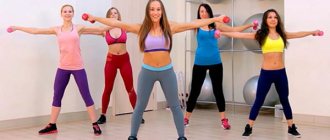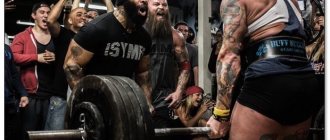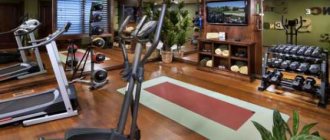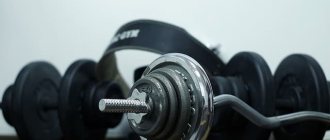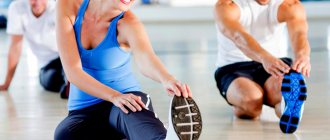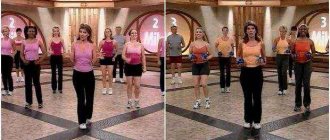- March 25, 2019
- Health
- Karina Perevalova
Keeping your body in good physical shape is a natural desire. It's no secret that for this you need to regularly expose the body to physical activity. However, the presence of varicose veins of the lower extremities often becomes a contraindication for sports. This is due to the fact that certain types of physical activity can significantly worsen the course of the pathological process. In this regard, many patients are interested in what exercises are not allowed for varicose veins of the legs, and which ones will bring invaluable benefits to the body.
Is it possible to exercise on exercise machines?
In this case, the determining factor is whether the person came to the hall for the first time or whether he has been visiting it for several years. Fitness is not a contraindication in the presence of varicose veins only if all exercises are performed correctly. As practice shows, beginners are more likely to get injured and harm their body without strictly following the algorithm of actions.
If a person has been going to the gym for many years, he knows the technique of doing the exercises by heart. In this case, the risk of injury and aggravation of the disease is much less.
But what should beginners do? If you have a desire to visit the gym, then you can study there. But it is important to remember two basic rules:
- During training, compression stockings must be worn on your legs. You can purchase it in pharmacies or salons specializing in the sale of orthopedic products. The prescription must be written by a doctor, based on the results of diagnostic tests.
- Classes must be supervised by a personal fitness trainer. He will tell you which exercises are prohibited for varicose veins, and will also make sure that the technique of the others is performed correctly.
During its development, the disease goes through 3 stages. It is the severity of the disease that is the determining factor in the choice of physical activity.
Stages of pathology:
- First. At this stage, there are no pronounced clinical manifestations. Often the only symptom is small blue nodules under the skin. At the first stage of varicose veins, you can exercise on exercise machines. But you need to choose those on which the lower limbs do not receive heavy loads. Immediately before starting your workout, you need to take time to do some quality stretching. This will prepare the muscle tissue for stress and prevent the development of thrombophlebitis. It is also important to know what not to do with varicose veins of the legs at this stage. Experts do not recommend running on a treadmill before starting a workout.
- Second. At this stage, the symptoms of the disease become more pronounced. The veins in the legs are much better visible. In addition, a person suffers from a feeling of heaviness in the lower extremities and swelling in the evening. Prohibited exercises for stage 2 varicose veins: strength training, running, exercise on an exercise bike, jumping and step. At this stage of development of the disease, experts do not recommend visiting the gym at all. They recommend swimming, water aerobics and yoga.
- Third. Characterized by the presence of pronounced symptoms. The venous nodes become huge, the skin in the affected area darkens, and the limbs swell not only in the evening. At this stage, you can go to the gym. But the load on the legs must be completely eliminated. In this case, doctors recommend doing water aerobics. In addition, walking will be useful.
Thus, you can visit the gym at any stage. However, you need to exercise exclusively under the supervision of an instructor, who will tell you what exercises cannot be done with varicose veins.
The benefits and harms of special gymnastics
With varicose veins, blood flow slows down, the walls of blood vessels weaken and stretch. In places where blood accumulates, the lumen decreases and blood clots form. The effectiveness of exercise therapy (therapeutic physical education) for varicose veins was proven in the 80s at the Moscow Medical Institute.
Two experimental groups were taken, in one of which the treatment was supplemented with daily physical education. In the control group, blood circulation was restored in 75% of the subjects; varicose veins did not have a pronounced and fleeting development. It is difficult to completely defeat varicose veins, but exercise therapy will help control the situation and prevent the disease from progressing.
Without constant movement, the blood in the veins stagnates, and the pressure of the blood flow increases. Special exercises will help not only keep muscles and blood vessels in good shape, but also regulate the water-salt balance in the body. With daily exercise, the legs become less swollen and tired, and excess fluid does not accumulate in the body.
With a weakened muscular system, varicose veins of the lower extremities progress at a rapid pace, and the patient’s condition can only be alleviated through surgery.
Physical therapy exercises for varicose veins are useful for patients for the following reasons:
- The venous outflow of blood in the vessels increases;
- The work of lymph is normalized;
- The patient's performance increases;
- Peripheral blood circulation improves;
- The tone of blood vessels and muscles increases;
- Pathologies in tissues slow down and resolve with less trauma.
Any exercises for a sick person should be selected by exercise therapy specialists. An ordinary gym trainer may not have a medical education, and excessive stress on diseased veins can lead to injuries.
Exercising with grade 3 and 4 varicose veins is dangerous. When the veins have undergone significant changes, and blood clots have formed in some places. When stressed, a blood clot can break away from the vessel wall and enter the bloodstream. A detached blood clot is fatal in 90% of cases.
Before exercise therapy, the doctor is obliged to examine the patient, take a general blood test, and conduct an ultrasound examination of the venous system. The exercise complex is selected individually for each patient depending on the overall clinical picture. There are general exercises from which the more suitable ones are selected.
A special exercise therapy complex has been developed for pregnant women who suffer from varicose veins of the extremities, uterus and groin area.
A standard set of exercise therapy exercises includes:
- Walking on a treadmill or in place;
- A set of exercises on the respiratory system (increase the amplitude of the diaphragm);
- Loads on the legs and pelvis (performed while lying on a flat floor).
Any exercises are designed to increase blood flow and tone the muscles of the pelvis and lower extremities.
Is it possible to do squats?
They not only help get rid of excess fat deposits. Squats help improve the shape of the gluteal muscles and lower limbs, and also increase a person’s endurance.
This physical exercise for varicose veins is not contraindicated, but only if the disease is at the first stage of development. Phlebologists say that in the presence of pronounced clinical manifestations, squats are prohibited.
The exercise must be performed under the supervision of a trainer. This is the only way to avoid the development of negative consequences, in particular, the worsening of varicose veins.
Rules for performing squats:
- You need to make sure your back is straight at all times.
- You need to bend your lower limbs at the knees slowly, avoiding sudden movements. This not only improves blood circulation, but also increases the elasticity of the walls of blood vessels.
- The feet should not leave the floor while squatting.
- You need to do the exercises without weights. This can lead to damage to already weakened blood vessels.
In addition, it is recommended to do light squats for the first few weeks. After this, you can move on to the deep ones.
General recommendations
There are rules that will help you avoid unnecessary stress and get the maximum benefit from exercise:
- Before performing physical activity, the body needs to be warmed up. Walking in place or on a treadmill for 10-15 minutes is suitable as a warm-up. Jumping and other sudden movements are not recommended. You are allowed to dance to rhythmic music.
- Any exercises are done until the first fatigue. The load should not exhaust the patient; mild fatigue is enough. If the patient is overweight and gets tired quickly, the load is reduced.
- During exercise, the patient's pulse is monitored. If the number of strokes exceeds 120 per minute, then you need to rest for 10–15 minutes.
- A set of exercises should take 15–20 minutes. Each exercise is performed for 3–5 minutes. It is allowed to increase the load, but gradually.
- It is not recommended to eat food an hour before physical activity.
After completing the exercises, you can squat for 5 minutes. This will restore breathing and normalize the pulse.
Is it possible to jump rope
This activity is very effective. That is why people who are interested in what exercises are not allowed for varicose veins often worry that jumping will be prohibited.
Their worries are not in vain: phlebologists do not have a common opinion on this issue. Some argue that jumping rope significantly improves the functioning of most internal organs and increases endurance without worsening the course of varicose veins. Others are sure that the load on the legs during exercise is colossal.
In this case, it is necessary to obtain permission from the attending physician. The specialist will analyze the diagnostic results and assess the balance of risk and possible benefit.
Even if the doctor gives permission to practice jumping, they must be performed while observing the following rules:
- Compression products should be worn on your legs during training.
- You need to lower your entire foot to the floor/ground. Jumping on toes is strictly prohibited.
After completing the workout, you need to take a contrast shower and treat the skin in the affected area with a venotonic.
Precautionary measures
When playing sports, if varicose veins are diagnosed, the patient must observe the following precautions:
- If you experience discomfort or heaviness in your legs, exercise should be stopped.
- The load should be coordinated not only with the trainer, but also with the phlebologist.
- Before classes, you should wear compression stockings.
- Periodically you need to give your legs a rest - do the “birch tree” or “bicycle” exercise.
By following the above recommendations, playing sports will be beneficial and will help in the prevention and rehabilitation of vein diseases. The wrong choice of activities and loads will only aggravate the situation and provoke complications.
Is it possible to dance
Phlebologists have a positive attitude towards this sport. During dancing, metabolic processes improve, the walls of blood vessels are strengthened, the outflow of liquid connective tissue and lymph is normalized, and muscles are strengthened.
Phlebologists recommend giving preference to:
- Bachate.
- Rumba.
- Salsa.
- Oriental and ballroom dancing.
But Irish people with varicose veins of the lower extremities are prohibited. This is due to the fact that such dances often lead to a worsening of the disease. A person develops more and more protruding blue nodes and redness occurs. In addition, the walls of blood vessels become even more fragile.
Dangerous disease
In itself, varicose veins and varicose protrusion are only a cosmetic defect, but complications that arise against the background of varicose veins can become very life-threatening. The most serious complications are:
- phlebitis of the subcutaneous and deep veins of the lower extremities;
- thromboembolism of the leg veins;
- pulmonary embolism;
- development of trophic ulcers on the legs;
- lymphostasis and swelling of the legs;
- tissue hypoxia and metabolic disorders.
Varicose veins also have a high risk of recurrence of the disease, even after surgical treatment.
One of the most dangerous complications is thrombosis. During hemostasis, blood flow slows down in dilated and deformed vessels, against the background of which the processes of blood clotting and blood clot formation are activated. Blood clots can clog subcutaneous and deep venous vessels. If massive thrombosis occurs, significant soft tissue swelling develops, blocking the outflow and inflow of blood.
Pulmonary embolism is one of the complications of varicose veins
Working with free weights
Both professionals and amateurs are interested in what exercises should not be done for varicose veins of the legs. Doctors prohibit lifting weights if you have this disease. Experts say that it is permissible to exercise with a weight not exceeding 5 kg. Unfortunately, sometimes the presence of varicose veins forces you to give up your usual type of physical activity.
What happens if a person ignores the ban:
- When lifting dumbbells or a barbell, the pressure in the veins will increase to critical levels.
- The valves of the blood vessels will not be able to pass enough blood to the heart muscle.
- Liquid connective tissue will begin to stagnate.
- Weak vessels will begin to be damaged at any time, which poses a serious threat to health.
Fortunately, there are currently many methods of surgical treatment of varicose veins. As a rule, this is what professional athletes resort to.
Doctors recommend that amateurs switch their attention to the hot iron. This is a type of fitness that involves a lot of physical exercise. For varicose veins of the lower extremities, a hot iron is not contraindicated only at the early stage of development of the disease. At a later stage it can be harmful. A set of exercises should be compiled by a trainer, taking into account the presence of an illness in a person. In addition, you need to exercise exclusively in compression hosiery.
For beginners, experienced instructors most often offer to master the bar. This is not a prohibited exercise for varicose veins of the legs. At the same time, even deep muscles are worked out during the plank, which is a good alternative to power loads, which are contraindicated in the presence of pathology. In addition, the exercise has several variations, thanks to which you can significantly reduce the degree of load on the lower limbs.
Techniques for varicose veins:
- Place your hands on the floor and place your feet on an exercise ball. In this case, the muscles of the back, arms and abs are well worked out.
- Place your hands on the floor. Bend your legs alternately at the knees and pull them towards your chest. This exercise is called a dynamic plank.
- Lie on your side. Bend your elbows and rest your hands on the floor. Lift your pelvis and legs off the floor. Only the side of the foot should rest against it. The legs should be perfectly straight.
Thus, phlebologists do not recommend exercising with free weights if you have varicose veins. As an alternative, you can consider a hot iron. But even in this case, the weight of the equipment should be no more than 5 kg.
How to pump up your legs and butt
How to pump your legs with varicose veins so that the exercises do not cause a worsening of the pathological process:
- Dynamic walking (treadmill) - stimulates venous tone and improves lymph outflow;
- Easy running – to minimize joint overload, you should do it on grass or a dirt road;
- Elliptical trainer - to strengthen the calf muscles, increase tone in the veins;
- It is allowed to pump up the abs and perform strength loads only while sitting or lying down to minimize the “impact” on the legs.
Swimming in the pool will help improve the tone of all muscle groups; this is a useful and strengthening procedure that will cure varicose veins at the initial stage of the disease.
You can pump up your butt with varicose veins using exercises that involve stepping on a bench without weights. Next, you should swing one or the other leg back, while standing on all fours, resting your hands and knees on the floor.
Additional exercises allowed for varicose veins
It is also effective to do:
- Alternating abduction of legs to the side;
- Exercise "bicycle";
- Exercise "scissors";
- Lifting the pelvis while lying down;
- Pushups.
Varicose veins and strength training are compatible only at the initial stage of varicose veins; they require consultation with a specialist, without putting excessive stress on the damaged areas. But you can do push-ups from the floor at any stage of the disease.
Useful exercises for legs with varicose veins
Doctors recommend taking long walks more often. Light running is also not prohibited. But it should be moderate, that is, characterized by short duration and average pace. The lower extremities should also be protected with compression products.
Running is contraindicated for people suffering from obesity and pathologies of the cardiovascular system. In combination with varicose veins, these ailments pose a serious threat to health. Especially if the disease is severe.
There are many exercises to treat varicose veins. Before performing them, you need to familiarize yourself with the basic rules:
- In order to prevent overstrain of both the blood vessels and the lower extremities in general, it is necessary to always exercise in compression hosiery.
- Choose only the right and comfortable shoes. It shouldn't be tight.
- If signs of leg fatigue appear, the workout must be completed.
- Drink as much water as possible during exercise.
- Exercises should be performed slowly, avoiding sudden movements.
- It is better to do several sets and rest for a long time between them, than to perform a small number of repetitions and not allow the body to relax.
What exercises can you do for varicose veins:
- Take a standing position, with your feet parallel to each other. Slowly rise onto your tiptoes, then just as slowly lower yourself down. The number of repetitions is 20.
- The starting position is the same. Stand on your toes and walk on them for 5 minutes. Then do the same, but on your heels.
- Walk for 5 minutes without lifting your feet off the floor at all. Many people associate this exercise with a ski step.
- In a standing position, place your right foot on your left foot. Rise slowly onto your toes. Then change legs. The number of repetitions is 10 for each limb.
- Sit on a chair. Raise your right leg slightly. Rotate your foot first clockwise and then counterclockwise. Change leg. The number of repetitions is 20 for each limb.
- In a sitting position, bend your toes. Maintain this position until significant tension occurs. Only after this can you relax. Number of repetitions - 10.
- Lie on your back on a hard and flat surface. Bend your knees. Use your limbs to imitate riding a bicycle. In this case, the legs should be fully straightened during the exercise. This way the lesson will be more productive.
- Lie on your back. Bend your knees and pull them towards your chest. After this, they need to be slowly straightened and lowered to the floor.
- The starting position is the same. Straighten your legs, extend your arms along your body. Slowly raise your lower limbs above the floor. Perform crosses with them. The rhythm should be average and breathing should be even.
- Lie down on the floor. Legs should be bent at the knees and slightly apart. Slowly raise your hips as high as possible. Don't rush down. Number of repetitions - 30.
- Take a knee-elbow position. Straighten one leg. Then it needs to be bent at the knee so that the limb forms a right angle. Slowly reach your heel towards the ceiling. The number of repetitions is 25 for each limb.
Leg exercises for varicose veins do not involve intensive muscle training. However, by doing them, you can still maintain good limb shape.
You don't have to force yourself. If your condition is unsatisfactory, it is better to skip the workout.
A set of exercises in the gym for varicose veins
For those who are just about to embark on the path of training and exercise in the gym during varicose veins, the best types of activity are gymnastics and cardio training, which must always be preceded by a thorough warm-up and warm-up.
However, gymnastic exercises require a certain amount of skill and coordination, so experts recommend that beginners first try just running or walking at moderate intensity on a treadmill for no more than half an hour.
You can train your feet with varicose veins, and at the same time your buttocks and calves, in dozens of different ways, but if we talk about cardio exercises, it is better to focus on the following:
- swimming on the back, breaststroke, freestyle;
- 15-minute sets on an exercise bike;
- exercises on the elliptical trainer;
- shuttle running, alternating with jogging;
- 5-minute sets of jumping rope.
This entire complex will initially harden the body, preparing it for more complex workouts that include strength elements.
Note! Typically, two to three weeks of preparation are sufficient, although the final decision rests with the trainer, who will objectively assess the level of progress of his patient with varicose veins.
Leg workout
Any use of a barbell, dumbbell or other weights is unacceptable during training in the gym for varicose veins to develop the legs, so the only basic exercises that remain are modified platform presses while lying or sitting.
The main difference is the position of the feet on the platform: the heels should protrude slightly to the edges of the platform, due to which a change in the direction of the load is achieved - instead of the buttocks and back of the thighs, the calves and ankle joints will work. You should also make sure that your knees are slightly tense, which will prevent potential hamstring strains.
In addition to bench presses, the following exercises that develop the lower limbs are available to patients with pathology of the blood vessels of the legs:
- swings performed alternately with straightened right and left legs in a knee-elbow position. Bringing the straight leg back involves the gluteal, ischial and popliteal muscles;
- classic bridge with legs on a platform and support on the shoulders;
- bending the legs while lying down on a machine, which affects, in addition to those listed, the calf muscles;
- seated leg extension with emphasis on the shins.
It is very important to take proper breaks between approaches, not standing or walking around the gym, but taking a lying position and throwing your legs above your body, so that the blood flows freely from the feet, calves and thighs, without lingering there.
Back
In the gym, with varicose veins of the legs, you should not focus only on developing the lower extremities, since for the harmonious development of the body, attention should be paid to all muscle groups. For example, one of the key exercises for the back is the row of blocks to the stomach in a sitting position, in which the legs should be parallel to the floor at the level of the pelvis.
In addition to stressing the back muscles, traction improves posture and opens the chest, allowing for free breathing. It is advisable to select exercise equipment for such activity that is equipped with a chest support, since without them the spine will be overloaded in an unprepared person.
A similar exercise is the pull of a vertical block to the chest; it provokes pressure in the venous vessels, so after each approach it is necessary to unload the legs.
Hyperextensions performed on a simulator to develop the muscles responsible for straightening the back are also suitable. Since this is a rather difficult exercise, after completing the approaches, experts recommend relieving tension by lying on your back and raising your arms and legs up (you can shake them a little for greater relaxation).
Chest and Shoulder Workout
With the chest muscles, everything is simple: any horizontal or inclined presses or dumbbell flyes are suitable, but you should remember two rules: your feet must be strictly on the platform or bench, and the selection of weights must be regulated by the trainer.
As for the shoulders, the most effective loads will be:
- lifting the barbell while lying on an inclined bench in front of you to pump the delta, infraspinatus and upper pectoral muscles;
- on an inclined bench, face up and feet on the platform - lifting dumbbells in front of you;
- Lifting dumbbells up and to the sides works in a similar way, but you should lie alternately on your left and right sides, raising your arms from your hips to a position parallel to the floor;
- seated barbell press.
How to train your arms?
A basic exercise for the arms that patients with varicose veins can practice at home is arm extension with dumbbells while lying on your back, while your legs should rest on the platform. The same can be done by replacing the dumbbells with a barbell, which will involve not only the biceps and triceps, but also the triceps muscles of the shoulders.
Additionally, you can try doing weighted arm curls while sitting on an incline bench, which will also work the pectoral muscles at the same time. Using light dumbbells, you can make circular movements with your arms as a rest, dispersing blood through the vessels.
What exercises should you not do if you have varicose veins in your legs?
Regular exercise is an excellent prevention of the disease. In addition, if the body is constantly exposed to moderate physical activity, the disease often stops its development. However, there are a number of exercises that are not at all compatible with the disease. This is due to the fact that they contribute to the progression of pathology and, accordingly, a deterioration in the quality of life.
What exercises should not be done with varicose veins of the legs:
- Lunges.
- Squats with heavy dumbbells or a barbell, especially deep ones. As mentioned above, the exercise can be done at an early stage of the disease, but without the use of additional equipment.
- Everything that is included in the training plan of weightlifters.
In addition, it is unacceptable to climb rocks and play football for a long time. This is the main list, it can be supplemented by the attending physician. It is he who can provide information about what exercises cannot be done with varicose veins of the legs, based on the results of laboratory and instrumental studies.
Features of training
Varicose veins disrupt the functioning of blood vessels, and physical exercise restores blood circulation in the body, normalizes blood pressure, and strengthens muscles. Moderate exercise has a particularly beneficial effect on heart function.
If vascular diseases are already making themselves felt, then you cannot work out in the gym on an equal basis with everyone else. The trainer must select an individual set of exercises adapted to your gender, age, condition and diagnosis.
Varicose veins require a special approach. When training in the gym, the following principles should be observed.
- The use of compression hosiery regardless of the stage of development of the disease.
- Loads on any muscle group with varicose veins should be dynamic. This principle can be expressed in the phrase: it is better to do more movements with light dumbbells than to hold a heavy weight in one position for a long time. Men especially should observe this principle.
- You should avoid deep squats, exercises with a barbell, as well as exercises that put pressure on the leg muscles.
- Allowed physical exercises must be carried out regularly, at least 2 times a week.
A properly selected complex and moderation of loads will help stop varicose veins at an early stage of development.
During training, it is necessary to wear compression stockings, regardless of the stage of development of the disease.
Prohibited and permitted sports
Phlebologists note that if you have an illness, it is unacceptable to do:
- Powerlifting.
- Run fast.
- Step aerobics.
Participation in these sports negatively affects the condition of the walls of blood vessels. Against the backdrop of high-intensity loads, the pressure indicator increases significantly. As a result, the walls of the blood vessels are stretched. A natural consequence is the formation of new nodes.
Phlebologists recommend paying attention to the following sports:
- Water aerobics. Exercising in water helps improve the condition of both skin and blood vessels. In addition, swimming in a short time helps to get rid of excess weight.
- Nordic walking. During exercise, the pressure in the veins decreases, due to which the vessels are able to function normally.
- Yoga. Most asanas are performed with raised legs. In this regard, all phlebologists agree that yoga is the best sport for varicose veins.
- Pilates. During exercise, the lower limbs experience virtually no stress.
Both a trainer and a doctor can provide information about what not to do with varicose veins of the legs. However, it is preferable to first consult a phlebologist. The doctor will help you decide on the type of sport based on the results of diagnostic studies.
Stages of varicose veins and exercise program
There are different exercises for each stage of varicose veins. At the onset of the disease, doctors advise increasing physical activity, eliminating prohibited sports. At the second stage of the disease, you can start visiting the pool and physical therapy classes, during which the doctor will select special exercises to maintain the tone of the veins. For the third stage of varicose veins, exercise therapy is indicated, consisting of a special exercise program. Other types of physical activity should be prescribed by a doctor after a thorough examination of the condition of the veins.
What is prohibited for varicose veins of the lower extremities
It often happens that a person engages in only permitted sports and follows all doctor’s recommendations. But the disease continues to progress. In this case, you need to analyze your lifestyle.
What not to do with varicose veins on the legs:
- Allow extra pounds to appear. Obesity is one of the main provoking factors in the development of the disease. The diet for varicose veins is not strict, but it is necessary to follow it. The following products should be excluded from the diet: flour and confectionery products, animal fats, spicy and salty foods, coffee, chicory, alcohol-containing drinks, celery.
- Lead a lifestyle that does not involve physical activity. In this case, we are talking not only about employees of various offices whose work is sedentary. People who spend most of the day on their feet are also at risk. Prime examples are chefs and hairdressers.
- Honey and cupping massage. Currently, these procedures are very effective in the fight against excess fat deposits. And many patients resort to them, refusing to engage in prohibited sports. However, during a honey massage, the risk of damage to the veins increases significantly. This is due to the fact that the procedure is associated with a pronounced mechanical effect on the tissue. Cupping massage is contraindicated due to the fact that during its implementation the pressure indicator increases significantly.
- Self-prescribe combined oral contraceptives. This applies to women. When taking incorrectly selected pills, the liquid connective tissue begins to thicken, which leads to a worsening of the situation.
- Carry out wraps. In most cases, the body temperature rises locally during the procedure. As a result, the veins expand and the pressure in them increases. A natural consequence is the formation of new nodes.
What else is not allowed for varicose veins on the legs? Patients need to avoid uncomfortable shoes. Women are strictly prohibited from wearing high heels.
Thus, to stop the progression of the disease, it is not enough to choose the right sport. It is important to make adjustments to your overall lifestyle.
What are varicose veins?
Varicose veins occur due to weakness of the valves and vessel walls, which means a decrease in the tone of the veins in the legs. It is because of this expansion that the blood speed slows down, causing blockage of both small and large vessels.
In this regard, physical activity strengthens blood vessels, increasing their tone, and on the other hand, putting additional stress on the walls of blood vessels, expands them, making the veins even wider.
After this, many will have a question - so what to do? Of course, leg training is necessary, but it is necessary to choose a type of load in which the force on the legs will be minimized.
In general, you need to eat fish and ride a moped :), and now in more detail how to do this:
Recommendations for training
However, not all sports are acceptable. To ensure that exercise does not harm you if you have varicose veins, you must adhere to some medical recommendations.
Since varicose veins and sports are compatible, questions may arise about where to start and what type of exercise is best for varicose veins on the legs.
If you have decided to start playing sports with varicose veins of the lower extremities, then the first thing you need to do is visit a doctor. During a visual examination, a specialist will determine the stage of the disease, assess the condition of the veins and give individual recommendations on those sports and exercises that will be most useful and effective in your case.
There are 5 degrees of the disease, each of which is more severe than the previous one, but still allows for sports activities.
The first degree is the easiest: it is practically undetectable, since there are no visual manifestations and no specific pain. A person feels this stage in the form of heaviness and fatigue in the legs in the evening after a busy day at work or after a long walk. People rarely take such fatigue seriously and do not consult a doctor. At this stage, almost all types of physical activity are allowed. It is worth excluding only those that lead to excessive stress on the legs:
- Skydiving;
- rock climbing;
- long distance running;
- lifting weights.
If at this stage of the disease you regularly train, dosing loads, then you can completely get rid of varicose veins.
Stage 2 of the disease is characterized by pain, swelling, numbness of the fingers, and possible convulsions. At this stage, contraindications include aerobics, sports dancing, and timed running. Calm walks and Nordic walking are best. You can go to the gym with grade 2 varicose veins, but you should not exercise on machines that involve lifting weights. It is better to do yoga or develop a set of exercises aimed at stretching.
The third degree of varicose veins is considered moderate in severity. It is accompanied by such signs as:
- leg pain;
- fast fatiguability;
- severe swelling;
- numbness of the toes and their acquisition of a bluish tint;
- curvature of the veins and their protrusion to the surface;
- development of sclerosis, phlebitis.
At stage 3 of the disease, restrictions on sports activities increase. Weightlifting and strength training for grade 3 varicose veins should be completely avoided. Leg training should be done with minimal stress to prevent overwork. It is better to give preference to complexes aimed at stretching, but other types of physical activity are also suitable:
- jogging;
- walking;
- swimming;
- yoga;
- martial arts classes.
The fourth degree of varicose veins is severe and is accompanied by:
- deep penetration of phlebitis;
- development of trophic ulcers;
- inability to stand on your feet for several hours at a time.
But even with such symptoms, you should not give up training. You can do yoga and stretching while doing exercises while lying down. If your physical fitness allows, you can perform headstands and exercises with raising your legs up, for example, “Birch”.
However, in most cases, patients with grade 4 varicose veins have a number of concomitant diseases, such as heart disease, atherosclerosis, and excess body weight. Therefore, only a doctor should determine suitable training complexes and loads. Training is also best done under the supervision of a specialist.
With grade 5 varicose veins, the patient is almost confined to a chair or bed. It is difficult to train in this position. But in a hospital setting, the patient can perform a number of physical therapy exercises under the supervision of specialists.
Regardless of the degree of development of varicose veins, in order to get the maximum effect from training, you should follow a few more recommendations:
- The best time to train legs for varicose veins is 1.5 hours after waking up and 2.5-1.5 hours before bedtime.
- If your health begins to deteriorate during training, it should be stopped immediately.
- You can exercise only if there is no feeling of increasing heaviness or pain in your legs.
- During physical activity, blood circulation is activated, which means the pressure in the veins of the legs increases. To reduce the likelihood of developing thrombosis, it is necessary to introduce foods that reduce blood clotting into the diet. These include: red currants;
- citrus;
- ginger;
- garlic.
Important information: How to treat (remove) varicose veins on the legs to get rid of spider veins
Load selection
Regardless of whether you decide to go to the gym, do yoga, or jog in the evenings, choosing the right load for varicose veins is an important condition for achieving a therapeutic effect. When starting to train, most beginners, when choosing a load, are guided by their own feelings and ideas about difficulty, which is erroneous and dangerous. It may be easy for a man to lift dumbbells weighing 5-10 kg, but with varicose veins, such weight already poses a danger to the veins of the lower extremities.
Another danger when choosing a load on your own is an incorrect assessment of the intensity and duration of the workout, which can also lead to fatigue, overtraining and increased pain in the limbs.
In order not to harm your own health, it is better to entrust the choice of suitable loads, as well as the selection of a set of exercises for varicose veins, to a specialist.
Suitable clothing
Sports with varicose veins require the use of special clothing. This applies to all types of training, except swimming. Protecting blood vessels in case of varicose veins on the legs with the help of special compression garments is a prerequisite for even light and short-term training. Underwear supports weakened muscles and prevents blood from stagnating. However, you should not wear compression shorts: they increase the pressure in the superficial veins of the leg.
If you are jogging or walking outside (even in warm weather), you should wear knee-high socks or leg warmers. Such measures help relieve pain and effectively inhibit the progression of varicose veins. In winter, you need to make sure that your feet are warm, for which you should wear warmer clothes, for example, insulated leggings.
Shoes should be comfortable and suitable for running (walking), this will help reduce the load on the vessels with varicose veins in the legs and avoid pain. If you have flat feet, you need to use special orthopedic insoles.
Cardio exercises for varicose veins
A special set of exercises designed to burn fat is not recommended for varicose veins of the legs. But there are a number of exercises that can help improve blood circulation and lose weight at the same time.
Such exercises include:
- moderate exercise on an exercise bike;
- swimming;
- walking;
- leisurely run.
It is important that training is not moderate. It is not advisable to use everything at once. It's better to alternate classes. Walk today and run in a couple of days.
If it is not possible to wear compression garments in the pool, then their presence is mandatory during all other workouts. The fitness trainer, the attending physician and the patient himself are the best team in the fight against such a disease. All decisions must be coordinated so as not to harm or aggravate the situation. Professionals will never ignore the problems of their patient or client.
What to do carefully
Exercises for varicose veins, such as running and walking, should be done with caution. When practicing both sports, it is necessary to carefully monitor the loads, preventing your legs from overloading and getting tired. At the initial stage, the duration of running and walking should not exceed 10-15 minutes at a calm pace. Then the duration of the training can be increased to 30 minutes. It is not recommended to stay on your feet longer without rest if you have varicose veins.
Exercises in the gym for varicose veins are also possible, provided that you work with minimal weights and adhere to the minimum intensity and duration of classes.
Run
There are several types of running:
- marathon;
- sprint;
- interval;
- jogging;
- using a treadmill.
For training with varicose veins of the legs of 1-3 degrees, only the last 2 options are acceptable. These types of jogging promote the most active contraction of the leg muscles, which improves blood circulation and helps fight painful venous congestion. When running with varicose veins, you should follow some rules:
- stick to an average running pace;
- exclude training with loads so as not to provoke thrombophlebitis;
- run briefly to avoid excessive stress on the lower limbs;
- Wear special clothing while jogging.
Important information: Cream based on horse chestnut for varicose veins on the legs and recipes for preparing ointments
Jogging is prohibited when:
- varicose veins 3-4 degrees;
- cardiovascular diseases;
- thrombophlebitis;
- a history of stroke;
- overweight.
Walking
Nordic walking, on a treadmill or a walk in the park is an excellent form of exercise for varicose veins. Movements while walking cause muscle contraction and their massaging effect on the veins. The blood picks up speed, rushes upward against the force of gravity, and the pressure in the veins decreases. Any type of walking reduces the risk of venous stasis and transformation of valvular insufficiency into varicose veins.
Daily walking for varicose veins in the fresh air or Nordic walking contributes to:
- maintaining muscle tone;
- increasing the elasticity of veins;
- improving blood circulation in the extremities;
- weight loss;
- removing toxins from the body;
- improvement of psychological state.
When starting walking, you should take into account the degree of damage to the veins and the general level of physical fitness. If you are overweight, your muscle corset is weakened, or the disease is quite advanced, then at first it is enough to climb the stairs to the 3rd floor and go down 1-2 times a day. The first walks outside should not exceed 10 minutes. When the muscles are strong enough, the duration of exercise can be increased to 30 minutes, while walking no more than 2-3 km. You should walk at a leisurely, measured pace and remember that only regular training will bring the expected result.
What sports should you not do?
Varicose veins and sports are not contraindicated. If you have varicose veins, the gym is also not prohibited. However, there is a large list of exercises and certain sports that you absolutely cannot do with varicose veins.
Prohibited items include:
- timed or long-distance running;
- deadlift and other static long-term loads;
- exercises on an exercise bike without a backrest;
- squats with weights (barbell, dumbbells);
- jumping rope;
- football, volleyball, etc.;
- Skydiving;
- stepper exercises;
- powerlifting;
- body-building;
- lunges;
- step and aerobics;
- lifting projectiles weighing more than 5 kg;
- exercises at the choreographic machine.
Jumping and squatting
Jumping and squats are exercises that are contraindicated for varicose veins. They cannot be practiced even in a mild form. Squats put maximum pressure on the legs, and jumping puts an ultra-high-impact load: both are unacceptable even with mild varicose veins. When performing jumps, with each landing, the knees, leg joints, spine, ankle joint area are affected, tension is created in the general vascular system, and blood flow slows down.
Squats and jumping with varicose veins can cause many complications, including leading to the development of thrombosis.
Causes
- Upright walking.
Researchers attribute lower limb disease to excessive pressure that the body puts on them. The column of blood extends to the heart muscle. Varicose veins are often called “the disease of saleswomen”, because... Many untrained people who spend a lot of time on their feet for work suffer from this disease.
It would seem that the solution is: don’t move, so as not to strain the blood vessels and everything will be fine? But no. With insufficient mobility, many modern professions also have a certain risk. Phlebologists suggested using the term “computer varicose veins”. Moderation is important in everything, as always .
- Weight gain.
Yes, yes, your extra pounds may well ruin the beauty of your legs. To prevent this from happening, you need to lose weight .
- Genetically determined predisposition.
In most people, this disease turns out to be a factor passed on from their parents. The statistics in this case are clear - in infants whose parents suffered from this disease, the likelihood of getting varicose veins increases to 70%.
However, any predisposition does not mean a disease. Varicose veins will develop only if there are external causes. Hereditary varicose veins often appear at a very early age.
- Endocrine and hormonal system disorders.
Due to the characteristics of the body in women, periods of hormonal imbalances become causes of blood stagnation. For them, the most dangerous periods are puberty, pregnancy, and the time after childbirth. The time when menopause occurs is also dangerous.
“These” days, your body and training
The female organs do not have enough hormones called estrogens. Instead, the hormone of the “corpus luteum” predominates. It is believed that it has a relaxing effect on the muscles, which contributes to the dilation of veins.
- Obstructions in the outflow of blood through the veins . They arise as a purely mechanical formation - a blood clot, a uterus, a tumor.
- Alcohol and smoking.
Alcohol contributes to dehydration of the body, and as a result, the veins and tissue do not receive the necessary nutrition. All this will lead to swelling of the body, especially the legs, increasing the load on them and the surface of the veins.
Alcohol causes red blood cells to stick together, increasing the risk of blood clots. This is DEADLY. The blood clot can break away from the vein walls and block the artery. For us ladies, extensive libations to Bacchus are especially dangerous, because... we are more prone to varicose veins.
You can drink no more than 50 ml of red wine per day. It must be natural, which means it will contain a lot of organic substances, about 24 different microelements (fluorine, potassium, manganese), malic and lactic acids. Such wines improve the elasticity of blood vessels, thin the blood, preventing the formation of blood clots, and improve metabolic processes in the body.
Smoking causes a loss of elasticity and strength of the blood vessel. Instead of being supplied with oxygen, tissues receive carbon dioxide. Lack of oxygen negatively affects the entire body, because... As a result of this addiction, many vital organs are deprived of the necessary nutrition.
The first signs of circulatory problems are indicated by a decrease in the temperature of the skin of the feet and hands. In the upper extremities, blood circulation is better due to constant movement. Therefore, smoking aggravates varicose veins, especially in the lower extremities.
In addition, smoking, like alcohol, provokes a surge in pressure, which means that a sharp expansion and subsequent constriction of blood vessels occurs in the body (when drinking alcohol, vice versa when smoking). Those. Stagnation of blood flow after three glasses and a couple of cigarettes is guaranteed, as are problems with blood vessels.
By the way, the causes of incredible headaches with a hangover are nothing more than a sharp dilation and subsequent narrowing of blood vessels, coupled with high blood pressure.
- Stress and nervous disorders affect the condition of blood vessels.
Constantly being in a state of physical and emotional stress exhausts a person, forcing all systems of his body to work literally to wear out. During a stress reaction, the work of the cardiovascular, nervous, endocrine, immune and other systems is activated. Constant mobilization exhausts the body and leads to various abnormalities.
The vein walls contain nerve endings that give them elasticity. When pressure increases in them, exposure to toxins, alcohol, the lumen of blood vessels loses tone and expands.
Sleep is not only a pleasant pastime, but also medicine. How to get enough sleep and get up in the morning full of energy - in the article “Sleep is the key to health. Meditation and relaxation"
All these factors that contribute to the development of varicose veins can be overcome by taking care of your health.
Contraindications to classes
In any case, before going to the gym, people with varicose veins should consult a doctor for a preliminary consultation. Even if the answer is positive, don’t rush to give your best in every workout.
There are several conditions in which the doctor will probably prohibit physical activity, these include:
- Thrombophlebitis of the deep veins of the lower extremities. With thrombosis and inflammation, the vascular wall is very loose and can rupture during stress. There is also a risk of a blood clot breaking off and migrating into the pulmonary circulation.
- Edema and lymphostasis. With lymphostasis, circulatory failure occurs due to compression of the arteries and veins. During exercise, muscles consume a lot of oxygen, and due to insufficient blood flow, ischemia occurs, which can turn into necrosis.
- Trophic ulcers and skin necrosis.
- Obstruction of large veins and arteries.
Minor exercises have a place in the treatment of varicose veins. All classes must be carried out under the control of the patient's condition.

